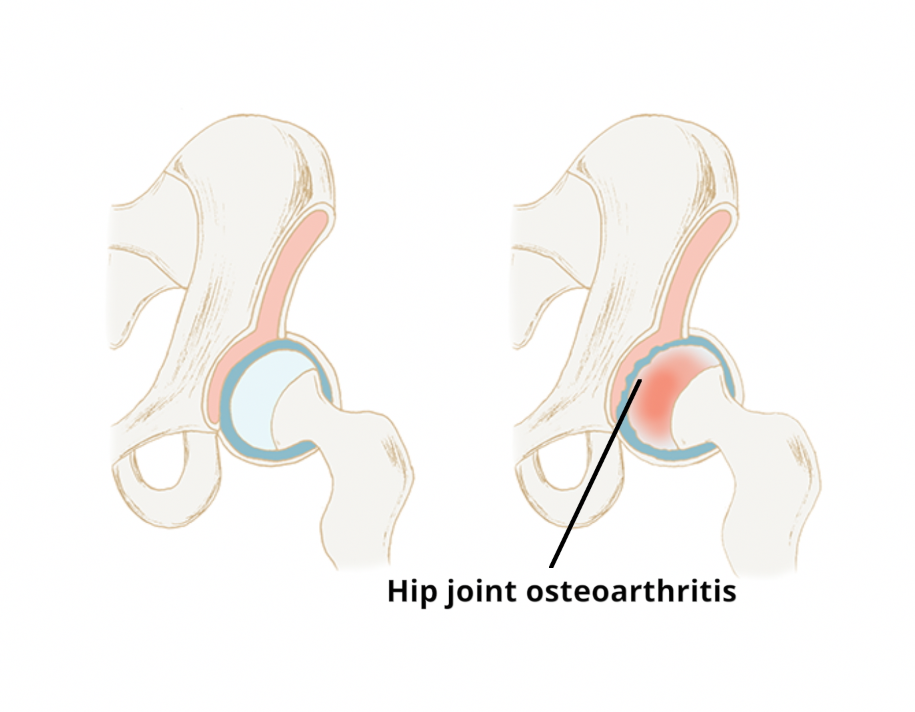
Osteoarthritis of the hip may cause pain and stiffness in the affected joint.
Osteoarthritis is the name given to age-related arthritis which causes the affected joint to become painful and stiff. The process of osteoarthritis involves wearing or thinning of the smooth cartilage joint surfaces as well as stiffening to the soft tissue surrounding the joint. These aspects combine to produce swelling, inflammation and pain.
Several factors normally combine to cause symptoms of osteoarthritis:
- Previous joint damage
- Increased bodyweight
- Age (risk increases with age)
- Family history (genetics)
General exercise such as walking, cycling and playing sports does not increase the risk of developing or increase the rate of deterioration of hip osteoarthritis.
How is hip osteoarthritis treated?
Non-surgical management
In the majority of cases, the symptoms of hip osteoarthritis can be managed effectively by non-invasive measures as described below. The most effective are exercises and in those who are overweight, weight loss.
Weight loss
An ideal BMI is less than 25. You can use a BMI calculator to advise if it might be advisable for you to try to lose some weight. Losing weight reduces the load on your joints as you move about. Evidence shows that weight loss can result in improved mobility. There is also evidence to suggest that weight loss alone may actually help to reduce pain. However, in combination with exercise, the results can significant.
For many people, losing weight feels like an uphill struggle. However, there is lots of support and advice available.
You can find some excellent ideas, including recipes and advice on making healthy food choices, on the NHS Change 4 Life website, which also has information about activities local to you.
ESCAPE Pain Programme
ESCAPE-pain is a rehabilitation programme for people with chronic joint pain of the knees and/or hips. It links self-management and coping strategies with exercise specific for each person. It helps people understand their condition, teaches them simple things they can help themselves with, and takes them through a progressive exercise programme so they can cope with pain better. to find out more please click here.
Exercises
Regular exercises to maintain flexibility and strength to the affected hip joint.
Using painkillers when needed
Over-the-counter analgesia is available through pharmacies when needed. Paracetamol is most commonly prescribed. Anti-inflammatories, such as Ibuprofen, are also used, but as there is little or no inflammation involved in osteoarthritis these are best avoided without discussing with your GP. Side effects are even more common than with paracetamol so please ensure to take appropriate medical advice. There is a good booklet on the versus arthritis website with information about the various drug options.
https://www.versusarthritis.org/about-arthritis/treatments/drugs/painkillers-and-nsaids/
Apos Therapy trial
For patients with advanced osteoarthritis who satisfy the referral criteria for surgery but wish to avoid it, Apos Therapy provides a treatment option. The concept is based around a shoe-like biomechanical device which can help to distribute the forces more evenly through the joint and aid in strengthening the joint. Your clinician will discuss this with you if this option is suitable.
Surgical management
Total hip replacement (THR) surgery is an effective option for patients with advanced stage hip osteoarthritis who:
- Have trialled a course of non-surgical management without success
- Have consistent, disabling pain significantly limiting mobility and/ or affecting sleep pattern
- Have a Body Mass Index (BMI) within a normal range or have made lifestyle changes to lose excess bodyweight
You may be asked to complete a questionnaire called an Oxford Hip score. This can help the clinician assess the impact of your symptoms which can be useful in assessing suitability for surgery.